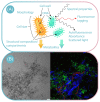Measurement Techniques to Resolve and Control Population Dynamics of Mixed-Culture Processes
- PMID: 33573846
- PMCID: PMC7612867
- DOI: 10.1016/j.tibtech.2021.01.006
Measurement Techniques to Resolve and Control Population Dynamics of Mixed-Culture Processes
Abstract
Microbial mixed cultures are gaining increasing attention as biotechnological production systems, since they offer a large but untapped potential for future bioprocesses. Effects of secondary metabolite induction and advantages of labor division for the degradation of complex substrates offer new possibilities for process intensification. However, mixed cultures are highly complex, and, consequently, many biotic and abiotic parameters are required to be identified, characterized, and ideally controlled to establish a stable bioprocess. In this review, we discuss the advantages and disadvantages of existing measurement techniques for identifying, characterizing, monitoring, and controlling mixed cultures and highlight promising examples. Moreover, existing challenges and emerging technologies are discussed, which lay the foundation for novel analytical workflows to monitor mixed-culture bioprocesses.
Keywords: bioprocess characterization; microbial co-culture; mixed culture.
Copyright © 2021 The Authors. Published by Elsevier Ltd.. All rights reserved.
Conflict of interest statement
Declaration of Interests There are no interests to declare.
Figures




Similar articles
-
Application of process analytical technology for real-time monitoring of synthetic co-culture bioprocesses.Anal Bioanal Chem. 2025 Jun 7. doi: 10.1007/s00216-025-05949-2. Online ahead of print. Anal Bioanal Chem. 2025. PMID: 40481350 Review.
-
Additive Biotech-Chances, challenges, and recent applications of additive manufacturing technologies in biotechnology.N Biotechnol. 2017 Oct 25;39(Pt B):222-231. doi: 10.1016/j.nbt.2017.09.001. Epub 2017 Sep 7. N Biotechnol. 2017. PMID: 28890405 Review.
-
Mixed consortia in bioprocesses: role of microbial interactions.Appl Microbiol Biotechnol. 2016 May;100(10):4283-95. doi: 10.1007/s00253-016-7448-1. Epub 2016 Apr 2. Appl Microbiol Biotechnol. 2016. PMID: 27037693 Review.
-
Mixed Culture Cultivation in Microbial Bioprocesses.Adv Biochem Eng Biotechnol. 2025;189:9-69. doi: 10.1007/10_2023_248. Adv Biochem Eng Biotechnol. 2025. PMID: 38418582 Review.
-
Mixed culture biotechnology and its versatility in dark fermentative hydrogen production.Bioresour Technol. 2024 Feb;394:130286. doi: 10.1016/j.biortech.2023.130286. Epub 2024 Jan 3. Bioresour Technol. 2024. PMID: 38176598 Review.
Cited by
-
Design and validation of a multiplex PCR method for the simultaneous quantification of Clostridium acetobutylicum, Clostridium carboxidivorans and Clostridium cellulovorans.Sci Rep. 2023 Nov 16;13(1):20073. doi: 10.1038/s41598-023-47007-w. Sci Rep. 2023. PMID: 37973932 Free PMC article.
-
Effects of the Coculture Initiation Method on the Production of Secondary Metabolites in Bioreactor Cocultures of Penicillium rubens and Streptomyces rimosus.Molecules. 2023 Aug 13;28(16):6044. doi: 10.3390/molecules28166044. Molecules. 2023. PMID: 37630296 Free PMC article.
-
Production of secondary metabolites in stirred tank bioreactor co-cultures of Streptomyces noursei and Aspergillus terreus.Front Bioeng Biotechnol. 2022 Sep 29;10:1011220. doi: 10.3389/fbioe.2022.1011220. eCollection 2022. Front Bioeng Biotechnol. 2022. PMID: 36246390 Free PMC article.
-
Application of the Fluorescence-Activating and Absorption-Shifting Tag (FAST) for Flow Cytometry in Methanogenic Archaea.Appl Environ Microbiol. 2023 Apr 26;89(4):e0178622. doi: 10.1128/aem.01786-22. Epub 2023 Mar 15. Appl Environ Microbiol. 2023. PMID: 36920214 Free PMC article.
-
Ergot alkaloid control in biotechnological processes and pharmaceuticals (a mini review).Front Toxicol. 2024 Oct 8;6:1463758. doi: 10.3389/ftox.2024.1463758. eCollection 2024. Front Toxicol. 2024. PMID: 39439532 Free PMC article. Review.
References
-
- Bertrand S, et al. Metabolite induction via microorganism co-culture: a potential way to enhance chemical diversity for drug discovery. Biotechnol Adv. 2014;32:1180–1204. - PubMed
-
- Shahab RL, et al. Consolidated bioprocessing of lignocellulosic biomass to lactic acid by a synthetic fungal-bacterial consortium. Biotechnol Bioeng. 2018;115:1207–1215. - PubMed
-
- Brethauer S, Studer MH. Consolidated bioprocessing of lignocellulose by a microbial consortium. Energy Environ Sci. 2014;7:1446–1453.
Publication types
MeSH terms
Grants and funding
LinkOut - more resources
Full Text Sources
Other Literature Sources

